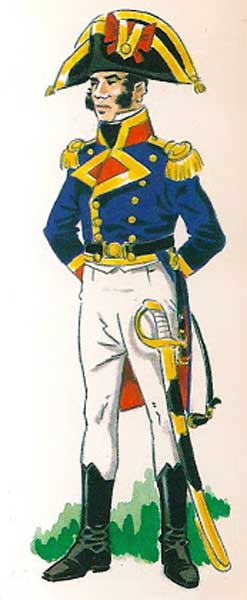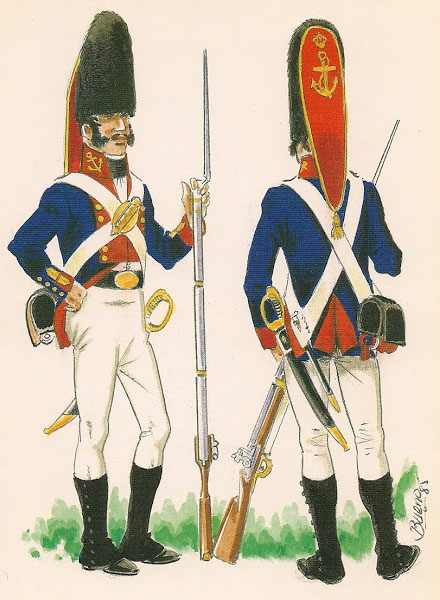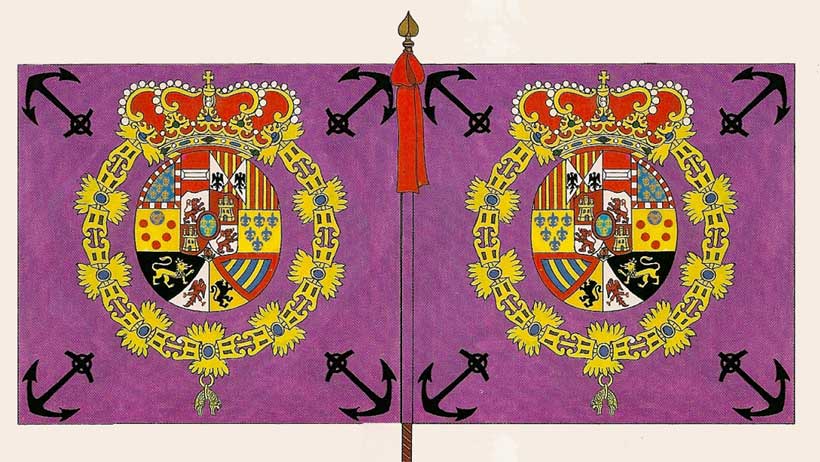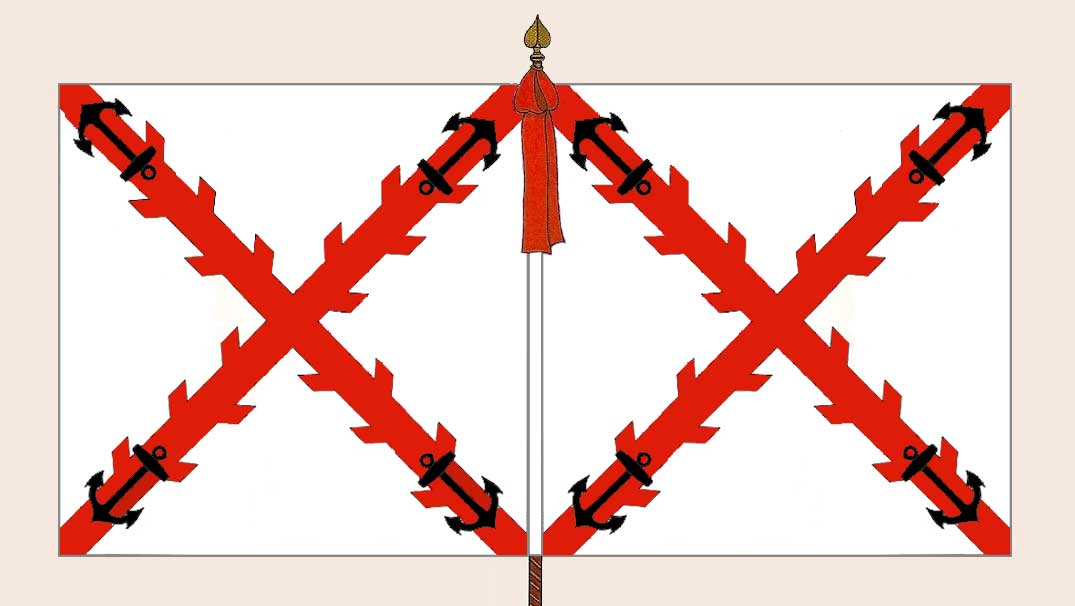|
Spanish Marine InfantryHistoryThe Spanish Marine Infantry (Cuerpo de Infantería de Marina) is the oldest marine infantry in the world, created by Carlos I on 27 February 1537. There was a seperate corps of Marine Artillery (Real Cuerpo de Artillería de Marina). On 7 January 1827, the marine infantry and artillery were merged into a single body called the "Royal Marine Brigade" (Brigada Real de Marina). At the start of the Peninsulat War, they were a well trained and disciplined fighting force which made a difference in the early fighting when many units were made from green recruits. They were involved in battles such as Talavera and Ocaña. Organisation1800At the beginning of the century, the 12 battalions of marine infantry had a total of 12,500 men and 425 naval officers. The marines had no officers of their own, they were officered by the navy. 1806In 1806 the total strength of the Marines had dropped somewhat, now only 12,096 men, still in 12 battalions; each of these battalions was commanded by a lieutenant-colonel (capitán de fragata), with two adjutants: one second captain (teniente de fragata) and one lieutenant (alférez de navío). Each battalion had 6 companies, each composed of: a captain (teniente de navío), a second captain (teniente de fragata), a lieutenant (alférez de navío), a second lieutenant (alférez de fragata), 9 sergeants, 2 grenadier corporals, 16 fusilier corporals, 3 drummers, 16 grenadiers and 122 fusiliers. In total 168 enlisted men. On 2 December 1806, with the advent of peace with Great Britain, the number of battalions was reduced to 4; 2 at Cadiz, 1 at Ferrol and 1 at Cartagena. 1809After the declaration of war with France, the marine infantry was in January 1809 again increased to 12 battalions; now grouped into 6 regiments of two battalions each. The 1st, 2nd and 3rd regiments were formed in Seville, the 4th and 5th regiments in Cartagena and the 6th regiment in Ferrol. Some sources show that the 4th and 5th regiments only formed 3 battalions instead of the expected 4. The regimental staff consisted of a colonel (brigadier or capitán de navío), a lieutenant-colonel (capitán de navío or capitán de fragata), a major (capitán de fragata or teniente de navío) and three adjutants (tenientes de fragata or alférez de navío). Each regiment also had a drum major (tambor mayor), two armourers (armeros) and 4 fifes (pífanos). Each regiment should have had two battalions each with 8 companies: one grenadier, one light (cazadores) and 6 fusilier companies. Each battalion had a standard-bearer (abanderado), a chaplain (capellán) and a surgeon (cirujano) Each company was composed of: a captain (teniente de navío), a second captain (teniente de fragata), a lieutenant, two second lieutenants, 1 first sergeant, 4 second sergeants, 8 corporals, 8 lance corporals, 3 drummers and 126 soldiers, for a total of 5 officers and 150 men. Uniforms1808At the outbreak of war, the uniforms and equipment of the Marine Infantry were of the same model as the line infantry, differing only in the colour. In 1802 it was decided that the headgear would be a black felt bicorne, without lace, adorned only with the red Spanish cockade. The coat would be dark blue coat with lapels, collar, cuffs and turnbacks in red. The collar badge was a gold anchor. The buttons were brass. White breeches were worn in the summer and dark blue in the winter. Short black gaiters and shoes were worn. For service onboard ship, a new brown uniform (jacket, trousers, fatigue cap) with red distinctions was provided. Sergeants: Sergeants wore the same uniform as the men, with a few additions. Their bicorne had gold lace. First sergeants wore two red epaulettes with gold braid. Second sergeants wore one red epaulettes with yellow silk on their right shoulder. Officers: Officers wore the uniform of the Royal Navy. A blue coat with red facings and buttons, lace and epaulettes in gold. Boots would be worn. Their bicorne had gold lace. When serving with the Infantería de Marina a gilt gorget could be worn, which was not part of the normal naval uniform. Drummers: In 1752 it was decided that drummers and fifes should wear reversed colours, i.e. red jackets with blue lapels. I could find no information about the uniform of the Peninular War, but it could be expected that they followed the earlier practice. Possibly with a coat trimmed with the red and white livery of the royal household.
1809-18141809: Due to the shortages after the start of the war, marine infantry uniforms became plainer, often with single-breasted short-tailed coatee. These plainer uniforms gradually replaced the older model when they had worn out. The bicorne was soon replaced by a round hat (top hat) or shako (illustrations show both the English style truncated cone shape and the French bell topped shako). 1813: From 11 February 1813, the uniform was to be a dark blur single-breasted short-tailed coatee with scarlet collar, cuffs, turnbacks and piping, blue 3 button cuff flaps piped scarlet, three rows of broad yellow lace or worsted cord on the chest. Brass buttons and gold anchor as before. The headgear was to be the English style truncated cone shaped shako with brass anchor shako plate and red "tuft" plume above the Spanish red cockade. Blue trousers were worn.
FlagsPrior to 1802 a battalion carried two 1762 pattern colours: one Coronela with the royal coat of arms on a field of purple and one Sencilla with the red cross of Burgundy on a field of white. The obverse (or front, when the stave is to the left) had the royal coat of arms shown normally while the reverse (or rear, when the stave is to the right) had the royal coat of arms reversed. The Royal Decree of 1802 set the number of flags to one per infantry battalion. From that time on, the battalions carried the Coronela and the excess colours were placed in storage (often in churches). When the regiments were formed, the 1st battalions carried the Coronela and other battalions the Sencilla.
Sources
|







